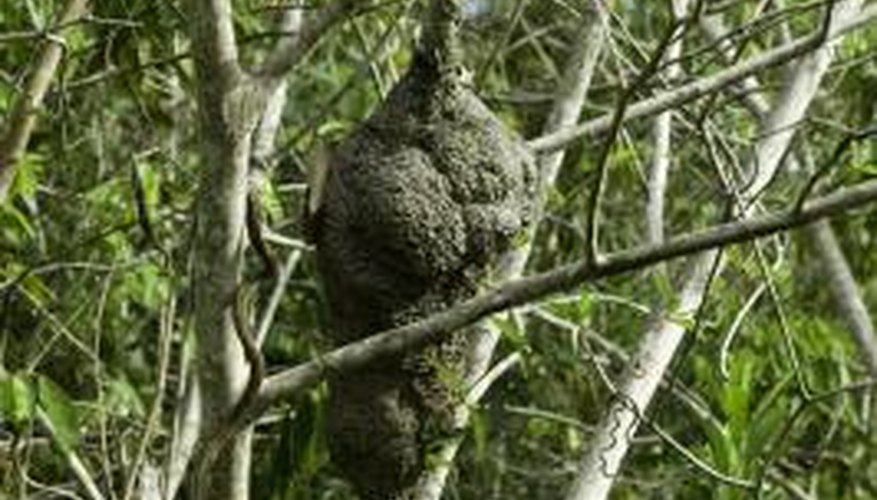Yellow jacket is the common name for wasps in the Vespula and Dolichovespula genus. Most people think of them as being yellow and black but they may also be black and white. While they have a bad reputation for their aggressive stings, yellow jackets should be considered beneficial because they actively prey on a number of insect pests. When you find these wasps have invaded your willow trees, your first instinct may be to kill them. You may change your mind once you understand more about the different types of yellow jackets.
Identifying
Identifying the exact species of yellow jacket can be difficult, but you can tell a lot about them by their nests. If the nest is located in a hollowed out portion of the tree, you are probably dealing with Vespula wasps, although you may be dealing with European hornets (Vespa crabro). Vespula yellow jackets usually build subterranean nests, but they also can build aerial nests. If the nest is hanging on a branch and looks like a large paper ball, you are dealing with a Dolichovespula variety. Depending on the species, these wasps may be yellow and black (aerial yellow jackets) or black and white (bald-faced hornets).
- Identifying the exact species of yellow jacket can be difficult, but you can tell a lot about them by their nests.
- If the nest is located in a hollowed out portion of the tree, you are probably dealing with Vespula wasps, although you may be dealing with European hornets (Vespa crabro).
Dealing with Dolichovespula
A nest found hanging on a willow tree branch was built by either aerial yellow jackets (D. arenaria) or the bald-faced hornets (D. maculata). These wasps are not as aggressive and do not aggressively seek out meats and sweets like other yellow jackets. If the nest is located in an area away from people, your best option is to wait for the colony to die naturally in the fall and remove the nest.
Dealing with Vespula
Of the three most common Vespula yellow jackets, the German yellow jacket (Vespula germanica) is most likely to build a nest in a tree cavity. Common yellow jackets (V. vulgaris) and Western yellow jackets (V. pennsylvanica) almost always build subterranean nests. Vespula wasps are more aggressive and can become major pests during picnics and outdoor gatherings. Use an aerosol wasp spray that will propel the insecticide to the nest's location. Wait until evening and spray the insecticide at the opening of the nest from a safe distance. Soak the nest thoroughly. Do not hold a flashlight to guide your aim as wasps will fly toward the light. Wait a day or two and check the nest. If all the wasps are dead, it is safe to remove it.
- Of the three most common Vespula yellow jackets, the German yellow jacket (Vespula germanica) is most likely to build a nest in a tree cavity.
European Hornets
Technically, European hornets (Vespa crabro) are not yellow jackets. They are the only true hornet found in the United States, although it is an introduced species. But its yellow markings often have people mistaking it as a yellow jacket. European hornets rarely create exposed nests, but they will build their nests in tree cavities. They also have been known to damage trees by chewing through the bark. Willow trees, which have thin bark, have been known to be damaged. In this case, they will need to be controlled in a similar manner as Vespula yellow jackets.
- Technically, European hornets (Vespa crabro) are not yellow jackets.
- In this case, they will need to be controlled in a similar manner as Vespula yellow jackets.
